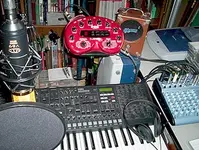1.) Throwing a subwoofer at a setup/environment problem is throwing water on a grease fire. All it will do is exascerbate and complicate the bass problems inherant in the current layout. Not to mention that getting a sub inplies that there is a weakness in the response of the main monitors themselves. While there may be more than a few people on this board that do not prefer the sound of the 824s, I don't think there is anybody who'll say that they are so deficient as to require subwoofers in order to be able to properly mix bass.
Throwing hardware at this problem is a waste of money that ignores the real cause of the problem.
2.) NL5 has it right; changing the desk setup can and will make a huge difference. Sometimes only 6" or a foot can make a difference of several dB in response. Getting the desk out of the corner (if possible) can make even more of a difference. Combine the two - get the desk out of the corner and fine-tune the positions of the speakers once you do that - and there is a good chance he might be able to get away without spending a
dime on bass traps. If he still has a bass problem after that, it will at least not be as bad and be easier to tame with such acoustic treatments.
3.) As far as the whole myth vs. non-myth thing with bass in a small room: Kylen, while I sympathize with your situation and believe you do have a true problem, it may be supporting anecdotal evidence, but it does not prove the rule.
I have a musician freind who has a small project studio setup in what was the smallest bedroom of his house. Many of us would laugh at the gear and the setup. His room is maybe 8'x10' if it's an inch, and for recording he has one MXL V69 and one SM58 going into a $99 mixer (Alesis MultiMix 6). The mixer is connected to his computer running Adobe Audition via his stock Soundblaster card. He monitors via a better-than-average sounding pair of Altec Lansing computer speakers (no sub).
Attached is a picture of what it looks like from his seat in his studio "cockpit" (the PC is off-camera to the right on the same desktop that the mixer is sitting on.) Note the the bookshelf/wall immediately in the background behind the Pod. The wall on the right is right at the rear of that desktop that's holding the mixer and the document scanner in the background. The left wall is maybe about a foot to the left of left edge of the pictured Korg keyboard (he has a compact fly fishing fly-tying station against that wall

).
And that's it. About 3 feet behind the photographer is a closet and a door to the hallway. Very tiny room, just a taste claustrophobic (and warm) when you get two people in there. Three people could maybe fit in if nobody sat down.
Sure the room is tiny and the gear less than stellar (though I do rather like that V69

). And sure he has designs on moving his stuff to a larger space, which would be great. But the fact is he has that room designed with plenty of variety of natural textures in the form of bookshelves, small desks, window curtains, and flat surfaces (including hardwood floor), quality selection of spekers matched to the room, and he takes his time getting the tracking good to begin with (not all necessarily in that room) and takes his time actually *mixing* his work.
My point is, this guy has zero bass response problems outside of the limitations of his computer speakers (which frankly sound better than your average $250/pr "studio monitors"), and his mixes are more balanced than half of the MP3s I have heard posted on this board. I have been in that room, and worked with him in that room, and frankly I would have no problem with the idea of making a quality mix in that room (though I'd do all the mixing ITB and take the Alesis and SB out of my mixing chain

).
G.
 )
)
 ).
).

